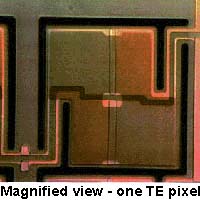

Creating tomorrow's infrared technologies and imaging solutions - today!
 |

Creating tomorrow's infrared technologies and imaging solutions - today! |
|
|
Patented Technology  The key technology for our exclusive camera systems is the patented Honeywell thermoelectric (TE) array. This array is fabricated using silicon microstructure processing, which is similar to silicon integrated circuit processing and is composed of 120 pixels arranged in a line. By moving this linear array of pixels, a two-dimensional image can be produced. Infrared Solutions has a world wide exclusive license to use this Honeywell technology in infrared cameras.
The key technology for our exclusive camera systems is the patented Honeywell thermoelectric (TE) array. This array is fabricated using silicon microstructure processing, which is similar to silicon integrated circuit processing and is composed of 120 pixels arranged in a line. By moving this linear array of pixels, a two-dimensional image can be produced. Infrared Solutions has a world wide exclusive license to use this Honeywell technology in infrared cameras.
The array:
The advantages of the "uncooled" thermoelectric detector over other infrared detectors:
Infrared radiation is electromagnetic radiation whose wavelengths are greater than those of visible light but shorter than those of microwaves.  In its most familiar form, it is radiated heat which can be sensed by our skin, yet cannot be seen by our eyes. All objects, whatever their temperature, emit infrared radiation. The intensity emitted depends upon the fourth power of the absolute temperature of the object. It also depends upon a material property of the object, termed "emissivity". An ideal infrared emitter, said to be a "blackbody," has an emissivity of unity. Most real objects have emissivities less than unity, and therefore emit less intense infrared radiation than a blackbody at the same temperature. In summary, the infrared emitting properties of an object are characterized by its temperature and its emissivity. Imaging Radiometer Temperature Measurement If it is necessary to measure the temperature of an object, one way is by directly contacting the object with a thermometer or similar device. In some instances, however, this is not practical. In such cases, it is possible to measure the temperature of an object from a distance using an instrument sensitive to infrared radiation. If the emissivity is known or can be estimated, then the temperature of the object can be determined. Such instruments capable of remote temperature measurement are termed "radiometers." Because infrared radiation is similar to visible light, only having a longer wavelength, it is possible to "see at night" by electronic cameras which respond to infrared wavelengths. Such systems, termed "thermal imaging systems," find widespread military use. For example, they enable our armed forces to view scenes at night which are displayed on TV screens. Such devices were widely used in the Gulf War, and are beginning to be used by law enforcement agencies.
Infrared cameras have historically used sensors made of exotic materials that require cooling to liquid nitrogen temperature (-320F). A technology breakthrough, achieved through military research, now makes possible the production of uncooled high performance detectors capable of sensing and measuring infrared energy. A significant new period in the application of IR technology is emerging, fueled by the commercial availability of this new technology. The invention makes possible the development of new, lower cost, and more easily operated infrared imaging devices. Two general approaches exist for making uncooled IR imaging devices. One uses a two-dimensional array of detectors. This permits "seeing" the entire scene through a lens at once and can produce real-time pictures at TV rates. The second approach uses a single row of detectors that is moved across the image plane of the lens, creating two-dimensional, "snapshot," images. Although slower than a two-dimensional array, the linear array is today significantly lower in cost. This camera can produce two-dimensional digital images by moving the linear array through the focal plane of the camera lens. It produces snapshot images much like a 35-millimeter photographic camera except the images are digital and displayed electronically. The same technology can be used in a fixed line scan mode to produce two-dimensional images where the target is moving. Today ISI produces three variations of the camera using the Honeywell linear thermoelectric array.
[ Home Page | About ISI | Products | Downloads | Applications | Contact Us | What's New ]
|